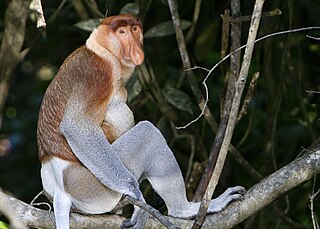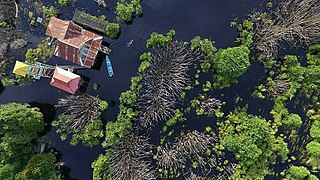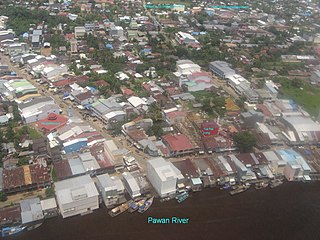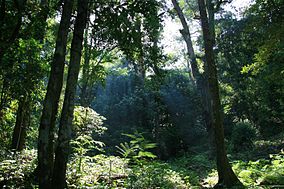
The bay cat, also known as the Bornean bay cat, is a small wild cat endemic to the island of Borneo that appears to be relatively rare compared to sympatric wild cats, based on the paucity of historical, as well as recent records. Since 2002, it has been listed as Endangered on the IUCN Red List because it is estimated that fewer than 2,500 mature individuals exist, and that the population declined in the past. The bay cat has been recorded as rare and seems to occur at relatively low density, even in pristine habitat.

The proboscis monkey or long-nosed monkey is an arboreal Old World monkey with an unusually large nose, a reddish-brown skin color and a long tail. It is endemic to the southeast Asian island of Borneo and is found mostly in mangrove forests and on the coastal areas of the island.

Gunung Leuser National Park is a national park covering 7,927 km2 in northern Sumatra, Indonesia, straddling the border of North Sumatra and Aceh provinces, a fourth portion and three-fourths portion, respectively. The national park, settled in the Barisan mountain range, is named after Mount Leuser (3,119 m), and protects a wide range of ecosystems. An orangutan sanctuary at Bukit Lawang is located within the park. Together with Bukit Barisan Selatan and Kerinci Seblat National Parks, it forms a World Heritage Site, the Tropical Rainforest Heritage of Sumatra.

The Borneo peat swamp forests ecoregion, within the tropical and subtropical moist broadleaf forests biome, are on the island of Borneo, which is divided between Brunei, Indonesia and Malaysia.
The gray tree rat is a species of rodent in the family Muridae and the only species in the monotypic genus Lenothrix. It is found in forests in Indonesia and Malaysia. A common species, the IUCN has rated it as being of "least concern".

Betung Kerihun National Park is a national park located in the Indonesian province of West Kalimantan, on the island of Borneo. The park was established in 1995, and has a total area of 8,000 km2 (3,100 sq mi) or about 5.5 percent of West Kalimantan Province area. Together with the 2,000 km2 (800 sq mi) Lanjak Entimau Wildlife Sanctuary in Malaysia, it has been proposed to form a World Heritage Site named the "Transborder Rainforest Heritage of Borneo".

Ketapang or Tau-pang in Teochew is the capital city of Ketapang Regency, one of the regencies of West Kalimantan province on the island of Borneo in Indonesia. Ketapang city is located at 1°51′S109°59′E and is a small city on the delta of the Pawan River. Ketapang is served by the Ketapang Airport.

Sabangau National Park is a national park in Central Kalimantan, a province of Indonesia in Kalimantan, the Indonesian part of the island of Borneo established in 2004. Between 1980 and 1995 the site was a massive logging concessions area. After 1995, the park became a site for illegal logging, which resulted in up to 85 percent of the 568,700-hectare total park area being destroyed. By 2012, less than 1 percent of the park's total area has been reforested and at the current rate, it will take several centuries to restore it to its pre-logged state.

The Borneo Orangutan Survival (BOS) Foundation is an Indonesian non-profit non-governmental organization founded by Dr. Willie Smits in 1991 and dedicated to the conservation of the endangered Bornean orangutan and its habitat through the involvement of local people. It is audited by an external auditor company and operates under the formal agreement with the Indonesian Ministry of Forestry to conserve and rehabilitate orangutans. The BOS Foundation manages orangutan rescue, rehabilitation and re-introduction programmes in East and Central Kalimantan. With more than 400 orangutans in its care and employing more than 440 people at a 10 sites BOS Foundation is the biggest non-human primate conservation non-governmental organization worldwide. Nyaru Menteng and Samboja Lestari are the BOS Foundation sites that have received most extensive media coverage. Nyaru Menteng, founded by Lone Drøscher Nielsen, has been the subject of a number of TV series, including Orangutan Diary, Orangutan Island and the series Orangutan Jungle School, airing since 2018.

The Borneo lowland rain forests is an ecoregion, within the tropical and subtropical moist broadleaf forests biome, of the large island of Borneo in Southeast Asia. It supports approximately 15,000 plant species, 380 bird species and several mammal species. The Borneo lowland rain forests is diminishing due to logging, hunting and conversion to commercial land use.

Tanjung Puting National Park is a national park in Indonesia located in the southeast part of West Kotawaringin Regency in the Indonesian province of Central Kalimantan. The nearest main town is the capital of the Regency, Pangkalan Bun. The park is famous for its orangutan conservation.

Willie Smits is a trained forester, a microbiologist, conservationist, animal rights activist, wilderness engineer and social entrepreneur. He has lived in Indonesia since 1985 and is an Indonesian citizen. He is married to Adrienne C. Watson since March 2016.

Deforestation in Borneo has taken place on an industrial scale since the 1960s. Borneo, the third largest island in the world, divided between Indonesia, Malaysia and Brunei, was once covered by dense tropical and subtropical rainforests.

The Borneo montane rain forests is an ecoregion on the island of Borneo in Southeast Asia. It includes montane tropical and subtropical moist broadleaf forests, also known as a cloud forests. The ecoregion is partly in East Malaysia and Indonesia (Kalimantan).

Pawan River is a major river of West Kalimantan, Indonesia. It has a length of 197 kilometres (122 mi). Tributaries include the Keriau River.

North Kayong Regency is a regency of West Kalimantan province in Indonesia. It covers an area of 4,568.26 km2, and had a population of 95,594 at the 2010 Census and 126,571 at the 2020 Census; the official estimate as at mid 2021 was 128,550. The principal town lies in Sukadana. The nearest airport is Ketapang Airport.

Sukadana is a town and regency seat of North Kayong Regency, on the island of Borneo. North Kayong regency is one of the regencies of West Kalimantan province in Indonesia. The nearest airport is Rahadi Osman-Ketapang Ketapang Airport.

The Rimba Raya Biodiversity Reserve, nearly the size of Singapore, consists of 64,000 hectares of bio-diverse tropical peat swamp forest that contain as much as 1,000 plant and animal species per hectare and is one of the most highly endangered ecosystems on the planet. The project area and ongoing initiatives focus on environmental conservation, community outreach, and climate control. Rimba Raya is home to one of the few remaining relic populations of wild orangutans and is the largest privately funded orangutan reserve in the world. The area is also one of the world’s largest repositories of carbon. Rimba Raya is the world’s largest REDD+ project -Reduced Emissions from (Avoided) Deforestation and Degradation (REDD). The project developer, InfiniteEARTH, is an industry pioneer, delivering the world’s first REDD methodology in 2009.
Panti, Rory O'Neill, is an Irish drag queen and gay rights activist

There are three species of orangutan. The Bornean orangutan, the most common, can be found in Kalimantan, Indonesia and Sarawak and Sabah in Malaysia. The Sumatran orangutan and the Tapanuli orangutan are both only found in Sumatra, Indonesia. The conservation status of all three of these species is critically endangered, according to the International Union for Conservation of Nature (IUCN) Red List.



















